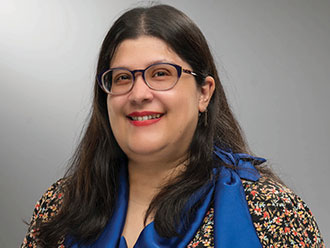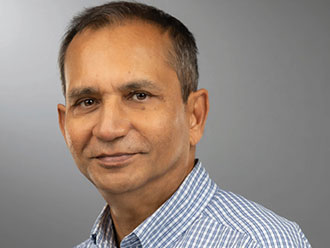Illustration by Dan Bejar
The COVID‑19 pandemic has revealed many things about the character of the United States and its people: the instability of the supply chain, the capability of scientists, the transmutability of misinformation, the flexibility of workers—and the inequality of the health care system.
The latter is not a new revelation; in fact, disparities in the way racial and ethnic groups are treated is a recurring theme over the history of epidemiology and medical intervention. Just over a century ago, for example, a global influenza epidemic shot through the U.S., killing some 675,000 people.
While a lack of data means that we can’t know precisely how many of that number were Black Americans, we do know that they were less likely to be infected than their white counterparts, possibly because housing segregation provided them a sort of natural quarantine. Yet Black patients who did contract the virus were far more likely to die than white patients because they received inadequate treatment—if they received any at all. Hospitals turned them away or sent them to basements for inadequate care.
Despite the advancements in health care and civil rights that have ensued over the past century, the COVID‑19 pandemic has followed a similar pattern, with Black and Latino people in the U.S. three times more likely to become infected than their white neighbors and nearly twice as likely to die from the virus. Overall, Black and Latino men faced the most significant drop in life expectancy in 2020 compared to all other groups.
Simply put, COVID‑19 revealed the deep racial and ethnic inequities in U.S. health care that have persisted for, essentially, its entire existence. At nearly every age group, Black Americans die at higher rates than white Americans. They have higher rates of diabetes, hypertension, heart disease, and many types of cancer. Even Black children have a 500% higher death rate from asthma compared to white children.
In 2021, Rochelle P. Walensky, M.D., director for the U.S. Centers for Disease Control and Prevention, put it plainly: “Racism is a serious public health threat that directly affects the well-being of millions of Americans. As a result, it affects the health of our entire nation.”
The University of Texas at Arlington is committed to addressing this critical issue head‑on. Researchers from a variety of fields are engaging in projects aimed at improving the health outcomes of marginalized groups, including strengthening communication tools for people of color, developing noninvasive blood tests for Black patients, evaluating the link between segregation and heart disease, and more.
Communication and the Pandemic
The emails arrived in Gabriela Wilson’s inbox one after another: notifications from her son’s school about classroom changes due to COVID‑19, potential exposures, and new cases. Because they were all written in English, the multilingual professor of kinesiology started to wonder how Spanish-speaking families were staying informed during the pandemic.
That became the spark for a multidisciplinary UTA team to develop a COVID‑19 navigator that presents educational health information to pre‑K‑12 students and their families. This curated content comes in both English and Spanish and covers public health practices, resources to support students’ mental health, and information on cases, strains, and vaccinations.
 “To reach marginalized communities, we cannot simply send in government health workers to promote vaccines. The younger generation has so much potential and power. If we can tap into that power, we can improve health outcomes.”
“To reach marginalized communities, we cannot simply send in government health workers to promote vaccines. The younger generation has so much potential and power. If we can tap into that power, we can improve health outcomes.”
Gabriela Wilson
For this work, the Coalition of Urban-Serving Universities in 2021 named UTA its inaugural Racial Justice and Equity Program Award Winner.
“Misinformation spreads like wildfire,” Dr. Wilson says. “The best way to fight it is to ensure that people have access to fact-based, up‑to‑date information.”
She and her team are now preparing to address the question of how such information should be delivered to maximize effectiveness. They are developing a community outreach model in which Latino teenagers are trained as health ambassadors to present information to their classmates and communities. Such ambassadors could help reduce vaccine hesitancy, which is higher among young Latinos in the U.S. than their older counterparts, according to a study by the Kaiser Family Foundation. Roughly 74% of Latino adults over the age of 50 said they were confident the vaccine was tested for safety and effectiveness; only 56% of those under the age of 50 had the same confidence.
Initially, UTA’s team will recruit and train 10 ambassadors at two schools located in at‑risk neighborhoods in the Dallas-Fort Worth Metroplex. It will then host focus groups to identify and better understand sources of misinformation. The researchers include Peggy Semingson, associate professor of linguistics; Denise Hernandez, adjunct assistant professor of kinesiology; and Chyng‑Yang Jang, associate professor of communication.
“To reach marginalized communities, we cannot simply send in government health workers to promote vaccines,” Wilson says. “The younger generation has so much potential and power. If we can tap into that power, we can improve health outcomes.”
No Needle Needed
For patients who require hemoglobin monitoring, the process is arduous and time-consuming, typically requiring frequent needle sticks and blood samples. Moreover, while noninvasive methods do exist, they are often inaccurate when monitoring people of color due to differences in skin melanin.
Recently, a team at UTA sought to address these challenges. Working with an Austin-based biotechnology firm, the researchers developed a new, noninvasive technology that can essentially monitor the concentration of hemoglobin through the skin. The device works particularly well in patients of color.
“This has the potential to both reduce health disparities and give people a great deal of freedom in monitoring their own health,” says Georgios Alexandrakis, associate professor of bioengineering, who led the project.
Hemoglobin is a protein in red blood cells that carries oxygen from the lungs to rest of the body. It is of particular importance because low levels are associated with severe cases of COVID‑19 and numerous other conditions, including anemia and lead poisoning.
Available devices monitor hemoglobin by using properties in the red-infrared spectra. Dr. Alexandrakis’ team at UTA developed an alternative that uses properties in the blue-green light spectra, which allows it to better measure hemoglobin in people with more melanin. A small probe is placed on the skin, measuring reflected light. The technology can be embedded in a wearable device, such as watch or a monitor.
So far, the team has evaluated the device in more than 30 participants. They compared the hemoglobin values measured by the device to those produced by currently available devices and by standard blood tests. Preliminary results suggest the new technology can estimate hemoglobin with better accuracy and consistency than other comparable methods.
The team plans to conduct follow‑up studies at Arlington hospitals. Members include Sanjay Gokhale, a medical scientist whose research focuses on spectroscopic properties of adult and fetal hemoglobin, and Michael Nelson, an associate professor of kinesiology.
“The technology has massive potential in health care settings, remote monitoring, and embodiment into wearables,” says Vinoop Daggubati, M.D., CEO of Shani Biotechnologies, which sponsored the project. “We are committed to closing the racial disparity ... to provide better care for African Americans, Hispanics, and people of color.”
From left: Bioengineering student Alexandra Hansard, medical scientist Sanjay Gokhale, and Associate Professor Georgios Alexandrakis
Segregation’s Pernicious Effects
Cardiovascular disease kills more Americans every year than anything else. But its impact varies widely by race and socioeconomic status.
On average, Black Americans develop the disease at a younger age and are 30% more likely to die from it than white Americans. The reasons why are complex, but the population tends to have greater rates of obesity, diabetes, high blood pressure, and high cholesterol— four major risks factors of heart disease.
But Yeonwoo Kim thinks there’s another important contributor: segregation.
The assistant professor of kinesiology is studying the extent to which poverty and neighborhood segregation contribute to cardiovascular disease by examining data from the Health and Retirement Study, which features comprehensive information on the health, health behaviors, and socioeconomic status of more than 26,000 Americans over the age of 50. The National Institute on Aging-supported study collected the data every two years between 2004 and 2014. Crucially for Dr. Kim, it deliberately oversampled people of color, thus providing a wealth of information about the communities at greatest risk of developing cardiovascular disease.
 “If we change neighborhoods, we could reduce an entire population’s risk. The magnitude of that impact would be great.”
“If we change neighborhoods, we could reduce an entire population’s risk. The magnitude of that impact would be great.”
Yeonwoo Kim
“If this research does find that neighborhood factors like racial segregation and income impact cardiovascular disease in minority and low-income people, then we can begin to approach those issues from a local-policies perspective and hopefully reduce cardiovascular disease for the entire community,” Kim says.
In a separate investigation, she is using the survey data to examine the effects of built and social environments— such as health care resources, food accessibility, socioeconomic status, crime prevention, and recreational activities—on health disparities found in people with cardiovascular disease.
“Essentially, we are able to look at where someone lived, whether they developed cardiovascular disease, and when they developed it,” she explains. “That allows us to delve into data on a neighborhood- by-neighborhood level.”
Examining the role geography plays in cardiovascular disease has the potential to help policymakers reduce incidents of it and improve public health overall. This is a relatively new way to approach racial and socioeconomic health disparities.
“If we change neighborhoods, we could reduce an entire population’s risk,” Kim says. “The magnitude of that impact would be great.”
Cardiovascular Disease in Women
Cardiovascular disease kills some 50,000 African American women every year. Yet they are among the most understudied group in the world on this topic.
A team of researchers in UTA’s Integrative Vascular Physiology Laboratory is working to address this knowledge gap. Led by Matthew Brothers, associate professor of kinesiology, the group is studying the neural and vascular mechanisms of elevated blood pressure and cardiovascular disease among this demographic.
“The lack of research on African American women and cardiovascular disease is alarming,” Dr. Brothers says. “We know that African American women have the highest rates of this disease, but the vast majority of historic research focuses on men.”
Using Doppler ultrasound, the team will capture images of volunteers’ blood vessels to evaluate how well they dilate and relax. Healthy blood vessels are soft and pliable to allow blood to flow easily. As arteries thicken and harden with age, they become narrow and stiff, increasing the risk for a heart attack.
The team is currently recruiting participants, including healthy, college-aged women. That will allow scientists to determine whether decreased blood vessel function is already present in otherwise healthy women. They will also study how antioxidants and other interventions, such as a vegan diet and acute thermal therapy, affect the blood vessels.
“We are trying to better understand cardiovascular disease and the genetic risk factors that we know contribute to hypertension,” Brothers says. “If we can learn more about the scientific reasons blood vessel health may be impaired, interventions can be developed and tailored to specific populations.”
He is working with Department of Kinesiology colleagues Paul Fadel, associate dean for research, and David Keller, associate dean and chair. Their project is funded by the National Institutes of Health.
Eventually, the group will collaborate with other researchers to study social determinants, environmental and socioeconomic factors, and their effect on cardiovascular disease risk.
“For now, we are looking at the physiology of the blood vessels,” Brothers says. “But we recognize there could be a host of factors that contribute to cardiovascular disease.”
The Stress of Prostate Cancer
Cancer places extraordinary stress on both patients and caregivers. Finding ways to cope is critical to maintaining quality of life during and after treatment, says Yue Liao, an assistant professor of public health in the Department of Kinesiology.
She is working with the MD Anderson Cancer Center to study the stress that Black prostate cancer patients and their partners face, how they cope, and how that affects their health behaviors.
 “We want to better understand our African American cancer patients and their partners’ daily stressors. That will enable us to develop culturally tailored interventions that could help couples cope with stress dues to cancer and adopt a healthier lifestyle.”
“We want to better understand our African American cancer patients and their partners’ daily stressors. That will enable us to develop culturally tailored interventions that could help couples cope with stress dues to cancer and adopt a healthier lifestyle.”
Yue Liao
“We want to better understand our African American cancer patients and their partners’ daily stressors,” Dr. Liao says. “That will enable us to develop culturally tailored interventions that could help couples cope with stress and adopt healthier lifestyles.”
Improving our understanding is important, Liao believes, because Black men in the U.S. are more likely to get prostate cancer than other men and twice as likely to die of the disease. Despite this gloomy picture, however, survival rates remain quite high.
“That means it is critical for these men to adopt healthy behaviors—such as healthy diet and being physically active—so they can go on to have the highest quality of life possible once treatment has ended,” Liao says.
Study participants will provide a snapshot into the lives of cancer patients and their partners by answering brief surveys throughout their days. In total, 240 patients and their partners will be asked about various stressors, including any related to financial worries, work-related problems, or relationship challenges.
The surveys will be administered through smartphones. Patients and caregivers will also wear activity trackers to show how active or sedentary they are so researchers can see how that might contribute to their stress.
“Smartphone technology allows us to seamlessly ask participants how they are feeling throughout the day,” Liao says. “This gives us a window into their lives that we did not have years ago.”
Funded by the National Institutes of Health, the project is led by Dalnim Cho, M.D., of MD Anderson’s Department of Health Disparities Research, Division of Cancer Prevention and Population Sciences.
Rethinking Health Messaging
How are people motivated to exercise? That question is at the heart of a multidisciplinary project at UT Arlington that is developing culturally appropriate, effective messaging for women of color at risk for heart disease, diabetes, and other complications due to obesity.
The University is providing funding for the project, which is led by Liao; Grace Ellen Brannon, assistant professor of communication; VP Nguyen, assistant professor of computer science and engineering; Halel Aghajani, research scientist at the UTA Research Institute; and Kyrah Brown, assistant professor of public health.
Obesity is a complex health issue resulting from a combination of causes and factors, including genetics and behaviors like physical activity and diet patterns. The team is investigating effective ways to promote active living in women of color with obesity.
To do so, the researchers will use health communication, data science, and health promotion techniques to develop personalized feedback for women of color who are at risk of heart disease, diabetes, and other complications due to obesity. The feedback will be based on individuals’ behavioral patters and personal backgrounds, similar to messages sent by activity trackers like Fitbit or exercise platforms like Peloton.
Study participants will evaluate sample messaging in English and Spanish and offer feedback about motivation and cultural appropriateness through a series of focus groups later this year.
Dr. Brannon, who is designing and assessing the communications, notes that fitness messaging has long neglected people of color.
“The importance of regular physical activity cannot be overstated. It offers both physical and mental health benefits,” she says. “But cultural beliefs and motivators vary by population, and we need to recognize and address these differences so that we can reach all women.”

